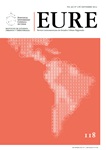Third generation indicators to quantify urban sustainability. Advances or stagnation?
DOI:
https://doi.org/10.4067/S0250-71612013000300008Keywords:
urban management, urban sustainabilityAbstract
The intricate relationships that characterize the metabolism of urban areas need to be viewed through simplified formulas, so that they can support the decision-making processes leading to urban sustainability. In the framework of the Co-evolution paradigm (Norgaard, 1984) and the calculation of Material Flow Analysis and the Local Ecological Footprint regarding the Metropolitan Region of Santiago (Chile) and the city-region of Bogotá (Colombia), Material Flow Analysis and the Local Ecological Footprint are shown as third-generation indicators Í€“ binding, local, synergic and cross-cutting Í€“ simultaneously incorporating several variables with broad categories and dimensions, and a high degree of contribution (80%) to the quantification of urban sustainability. The positioning of the local, through the local ecological footprint, also prevails in the improvement of indicators relative to the sustainability of a specific urban area, beyond the standardization of methodologies based on international comparisons or rankings.
ÍDownloads
Published
How to Cite
Issue
Section
License
Copyright (c) 2013 Revista EURE - Revista de Estudios Urbano Regionales

This work is licensed under a Creative Commons Attribution 4.0 International License.
Al momento de aceptar la publicación de sus artículos, los autores deberán formalizar la cesión de derechos de autor a EURE, según las condiciones establecidas por la Revista.
Ésta establece que el autor autoriza a EURE de manera gratuita, exclusiva e ilimitada a reproducir, editar, publicar, distribuir, publicitar, comercializar y traducir el artículo, a cualquier soporte conocido o por conocer y desarrollar.
Del mismo modo, los autores aseguran que el artículo propuesto es original, no publicado y no propuesto para tal fin a otro medio de difusión.


